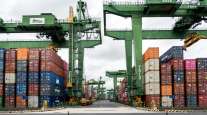Pacific Rim Nations Led by US Agree to Historic Trade Deal
A dozen Pacific Rim nations agreed to an historic pact that would cut trade barriers on items ranging from cars to rice, setting up a potentially contentious ratification vote before a skeptical U.S. Congress.
After a week of final talks in Atlanta, an agreement has been reached on completion of the Trans-Pacific Partnership, a pact more than five years in the making designed to boost commerce among nations that produce 40% of global economic output.
“This partnership levels the playing field for our farmers, ranchers and manufacturers by eliminating more than 18,000 taxes that various countries put on our products,” President Obama, who sees the pact as a key element in his “pivot to Asia” foreign policy, said in a statement Oct. 5. “It’s an agreement that puts American workers first and will help middle-class families get ahead.”
China was pointedly left out of the agreement, which supporters promoted as a counterweight to its growing influence. “When more than 95% of our potential customers live outside our borders, we can’t let countries like China write the rules of the global economy,” Obama said in the statement.
If implemented, it would be the largest trade deal the United States has negotiated since the North American Free Trade Agreement took effect in 1994. The three signatories to that agreement, the United States., Canada and Mexico, are included in this one, as is Japan.
The agreement will provide duty-free trade on most goods and reduced tariffs on others. It also will provide mutual recognition of many regulations, including an exclusivity period for biologic drugs, which are derived from living organisms, and patent protection for pharmaceuticals. That was one of the final topics that was settled in marathon talks, as developing nations sought to have quicker access to generic medications.
Negotiators also haggled over issues including Canada’s supply management system for dairy and other agricultural products, Australia’s demand for additional access to the U.S. sugar market and regional value rules for automobiles and auto parts.
Obama persuaded Congress to consider the measure under “fast track authority” — meaning it will be submitted for an up-or-down vote without amendments. Obama will have to notify Congress 90 days before he signs the agreement and publish the text 60 before.
The 12 TPP countries are Australia, Brunei, Canada, Chile, Japan, Malaysia, Mexico, New Zealand, Peru, Singapore, Vietnam and the United States.
“TPP is a comprehensive agreement that will open markets, set high-standard trade rules and address 21st-century issues in the global economy,” the U.S. Trade Representative’s office said in background documents.
TPP will promote jobs and growth in the United States and across the Asia-Pacific region, and “share American values and commitment to improve labor practices and elevate environmental standards around the world,” according to USTR.
Supporters of the pact, including the U.S. Chamber of Commerce, argue that the TPP will make it easier to sell made-in-America goods and services overseas and support U.S. jobs and economic growth.
Opponents, such as the AFL-CIO labor organization, argue that it will lead to additional outsourcing of U.S. jobs. They are expected to pressure Congress to reject that pact.
“The only way for this to end well for the American people, and our economy, is for Congress to reject this awful agreement, lock it in a metal safe and dump it at the bottom of the Pacific Ocean,” Charles Chamberlain, Executive Director of Democracy for America, said in a statement.
Ford Motor Co. is recommending Congress not approve the agreement in its current form because it fails to adequately address currency manipulation overseas, which may tip the playing field.
In a statement, Ziad Ojakli, Ford’s group vice president for government and community relations, urged the administration in a statement “to renegotiate TPP and incorporate strong and enforceable currency rules. This step is critical to achieving free trade in the 21st century.




